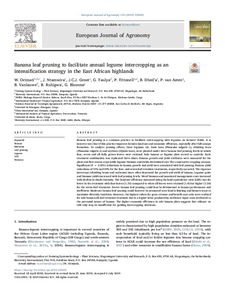| dc.contributor.author | Ocimati, W. |
| dc.contributor.author | Ntamwira, J. |
| dc.contributor.author | Groot, J.C.J. |
| dc.contributor.author | Taulya, G. |
| dc.contributor.author | Tittonell, P. |
| dc.contributor.author | Dhed’a, B. |
| dc.contributor.author | van Asten, P. |
| dc.contributor.author | Vanlauwe, B. |
| dc.contributor.author | Ruhigwa, B. |
| dc.contributor.author | Blomme, G. |
| dc.date.accessioned | 2019-12-04T11:36:16Z |
| dc.date.available | 2019-12-04T11:36:16Z |
| dc.date.issued | 2019-10 |
| dc.identifier.citation | Ocimati, W., Ntamwira, J., Groot, J.C.J., Taulya, G., Tittonell, P., Dhed’a, B., ... & Blomme, G. (2019). Banana leaf pruning to facilitate annual legume intercropping as an intensification strategy in the East African highlands. European Journal of Agronomy, 110, 1-12. |
| dc.identifier.issn | 1161-0301 |
| dc.identifier.uri | https://hdl.handle.net/20.500.12478/6178 |
| dc.description | Published online: 23 July 2019 |
| dc.description.abstract | Banana leaf pruning is a common practice to facilitate intercropping with legumes on farmers’ fields. It is however not clear if this practice improves farmers land-use and economic efficiency, especially after full canopy formation. To analyze pruning effects, three legumes viz. bush bean (Phaseolus vulgaris L), climbing bean (Phaseolus vulgaris L) and soybean (Glycine max), were planted under three banana leaf pruning levels in which four, seven and all fully grown leaves were retained. Sole banana or legume plots served as controls. Each treatment combination was replicated three times. Banana growth and yield attributes were measured for the plant and first ratoon crops while legume biomass and yields determined over five consecutive cropping seasons. Significant (P < 0.001) reductions in banana growth and yield were associated with leaf pruning. Banana yield reductions of 31% and 10% for the four- and seven-leaf retention treatments, respectively occurred. The vigorous intercrops (climbing beans and soybeans) more often depressed the growth and yield of banana. Legume grain and biomass yields increased with leaf pruning levels. Weed biomass and associated management costs increased with decline in shade intensity. The land-use efficiency measured using the land equivalence ratio (LER) was far lower in the treatment with four-leaves (1.10) compared to when all leaves were retained (1.4) but higher (1.54) for the seven-leaf treatment. Severe banana leaf pruning could thus be detrimental to banana performance and inefficient. Moderate banana leaf pruning could however be promoted were land is limiting and farmers want to maximize diversity/nutrition. However, the highest values for gross revenue and benefit-cost ratio were realized for sole banana-all-leaf retention treatment due to a higher labor productivity and lower input costs attributed to the perennial nature of banana. The higher economic efficiency in sole banana plots suggests that reliance on LER only may be insufficient for guiding intercropping decisions. |
| dc.description.sponsorship | Directorate-General for Development Cooperation and Humanitarian Aid, Belgium |
| dc.format.extent | 1-12 |
| dc.language.iso | en |
| dc.rights | Copyrighted; all rights reserved |
| dc.subject | Bananas |
| dc.subject | Intercropping |
| dc.subject | Legumes |
| dc.subject | Cropping Systems |
| dc.subject | Soybeans |
| dc.subject | Pruning |
| dc.title | Banana leaf pruning to facilitate annual legume intercropping as an intensification strategy in the East African highlands |
| dc.type | Journal Article |
| dc.description.version | Peer Review |
| cg.contributor.crp | Maize |
| cg.contributor.crp | Roots, Tubers and Bananas |
| cg.contributor.affiliation | Wageningen University and Research Centre |
| cg.contributor.affiliation | Bioversity International |
| cg.contributor.affiliation | Institut National pour l'Etude et la Recherche Agronomiques |
| cg.contributor.affiliation | International Institute of Tropical Agriculture |
| cg.contributor.affiliation | Instituto Nacional de Tecnología Agropecuaria |
| cg.contributor.affiliation | Université de Kisangani |
| cg.contributor.affiliation | Olam Internationl Ltd, Uganda |
| cg.contributor.affiliation | Université de Bunia |
| cg.coverage.region | Africa |
| cg.coverage.region | Central Africa |
| cg.coverage.country | Congo, Dr |
| cg.creator.identifier | Walter Ocimati: 0000-0001-6177-7073 |
| cg.creator.identifier | Godfrey Taulya: 0000-0002-5690-0492 |
| cg.creator.identifier | Piet van Asten: 0000-0003-0584-3552 |
| cg.creator.identifier | bernard vanlauwe: 0000-0001-6016-6027 |
| cg.creator.identifier | Guy Blomme: 0000-0002-3857-964X |
| cg.researchtheme | NATURAL RESOURCE MANAGEMENT |
| cg.isijournal | ISI Journal |
| cg.authorship.types | CGIAR and developing country institute |
| cg.iitasubject | Banana |
| cg.iitasubject | Crop Systems |
| cg.iitasubject | Food Systems |
| cg.iitasubject | Grain Legumes |
| cg.iitasubject | Soybean |
| cg.journal | European Journal of Agronomy |
| cg.howpublished | Formally Published |
| cg.accessibilitystatus | Limited Access |
| local.dspaceid | 106554 |
| cg.targetaudience | Scientists |
| cg.identifier.doi | https://dx.doi.org/10.1016/j.eja.2019.125923 |

